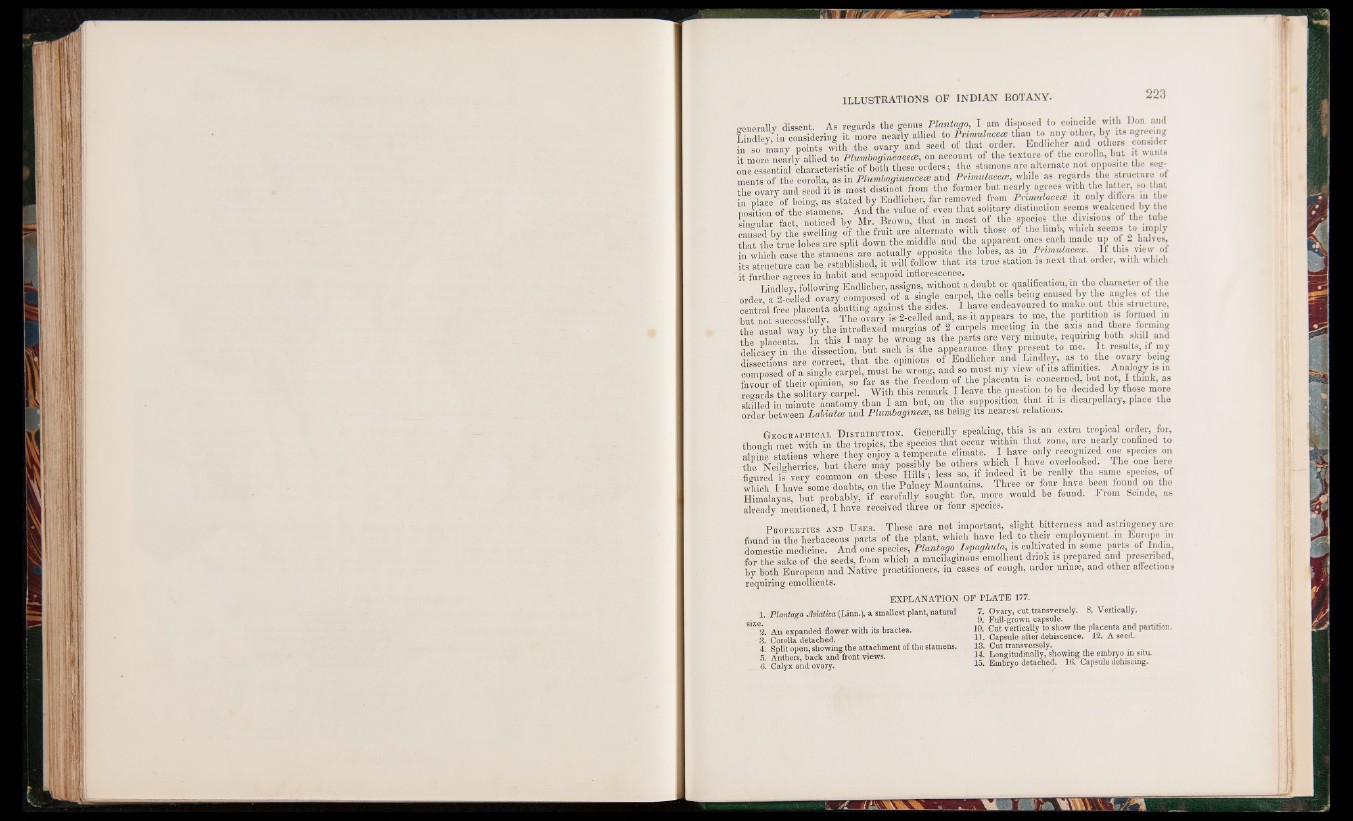
„„„„rally dissent. As regards the genus P l a n t a g o , I am disposed to coincide with Don and
f in dlev^n considering it more nearly allied to P r im u l a c e c e than to any other, by its agreeing
“ S r r r ^ t h the I M H seed of th a t order. Endlicher and others consider
it more nearly allied to P lu m b a g i n e a c e c e , on account of the texture of the corolla, but it wants
one essential characteristic of both these orders; the stamens are alternate not opposite the segments
of the corolla, as in P l u m b a g i n e a c e c e and P r im u l a c e c e , while as regards the structure of
the ovary and seed it is most distinct from the former but nearly agrees with the latter, so that
in place^of being, as stated by Endlicher, far removed from P r im u l a c e c e it only differs in the
position of the stamens. And the value of even th a t solitary distinction seems weakened by the
singular fact, noticed by Mr. Brown, th a t in most of the species the divisions of the tube
calmed by th^ swelling of the fruit are alternate with those of the limb which seems to imply
th a t the true lobes a r l split down the middle and the apparent ones each made up of 2 halves
in which case the stamens are actually opposite the lobes, as in P r im u l a c e c e . I f this view of
itL structure can be established, it will follow th a t its true station is next th a t order, with which
' it further agrees in habit and scaptiid inflorescence.
Lindlev, following Endlicher, assigns, without a doubt or qualification, m the character of the
order, a 2-ce led ovary composed of a single carpel, the cells being caused by the angles of the
central free placenta abutting against the sides. I have endeavoured to make out this structure,
hu“ not successfully. The ovary is 2-celled and, as it appears to me the partition is formed in
th e usual way by the introflexed margins of 2 carpels meeting in the axis and there forming
the placenta. In this I may be wrong as the parts are very minute requiring both skill and
delicacy in the dissection, h i t such is the appearance they present to me. I t results, if my
dissections are correct, th a t the opinions of Endlicher and Lindley, as to the ovary being
composed of a single carpel, must be wrong, and so must my view of its affinities. Analogy is in
favour of their opinion, so far as the freedom of the placenta g concerned, but not, I think, as
regards the solitary carpel. W ith this remark I leave the question to be decided by those more
S d in minute inatomy than I am but, on the supposition th a t it is dicarpellary, place the
order between L a b i a t e s and P l u m b a g i n e a , as being its nearest relations.
G eographical D istr ibutio n . Generally speaking, this is an extra tropical order, for,
though met with in the tropics, the species th a t occur within th a t zone, are nearly confined to
alpine stations where they enjoy a temperate climate. I have only recognized one species on
the Neilgherries, but there may possibly be others which I have overlooked. The one here
figured i s very common on these H ills; less so, if indeed it be really the same species, of
which I have some doubts, on the Pulney Mountains. Three or four have been found on the
Himalayas, hut probably, if cargfully sought for, more would be found. From Scmde, as
already mentioned, I have received three or four species.
P roperties a s » U ses. These are not important, slight bitterness and astringency are
found in the herbaceous parts of the plant, which have led to their employment in Europe m
domestic medicine. And one species, P l a n t a g o I s p a g h u l a , is cultivated m some parts of India,
for the sake of the seeds, from which a mucilaginous emollient drink is prepared and prescribed,
by both European and Natiye practitioners, in cases of cough, ardor unnas, and other affections
requiring emollients.
EXPLANATION OF PLATE 177.
1. P la n ta g o AsiaXica (Linn.), a smallest plant, natural
size.
2. An expanded flower with its bractea.
3. Corolla detached.
4. Split open, showing the attachment of the stamens.
5. Anthers, back and front views.
6. Calyx and ovary.
7. Ovary, cut transversely. 8. Vertically.
9. Full-grown capsule.
10. Cut vertically to show the placenta and partition.
11. Capsule after dehiscence. 12. A seed.
13. Cut transversely.
14. Longitudinally, showing the embryo in situ.
15. Embryo detached. 16. Capsule dehiscing.